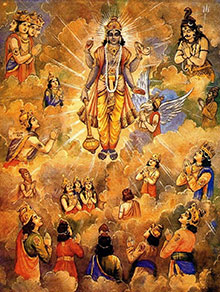
A selection from the book The Bhagavad Gita for Awakening,
available for reading online, as a free PDF download, or as a paperback or ebook.
Tapasya is practical (i.e., result-producing) spiritual discipline. Literally it means the generation of heat or energy, referring to spiritual practice and its effect, especially the “roasting” of karmic seeds, the “burning up” of karma. It also refers to the heat necessary for the hatching of an egg. Without tapasya there is no significant spiritual progress. So Krishna tells us of three levels of tapasya as well as its characterization according to the dominant guna of the persons engaging in tapasya..
Tapasya of the body
“Reverence for the devas, the seers, the teachers and the sages; straightforwardness, harmlessness, physical cleanliness and sexual purity; these are the virtues whose practice is called austerity of the body.” (Bhagavad Gita 17:14)
Reverence (pujanam) is internal, so why does it come first in the list of physical austerity? Because Krishna is not thinking of mere philosophizing or abstraction–in other words, empty words. He is thinking of action, of kriya, which creates positive karma in the form of purification and enlightenment. Puja is the word usually translated “worship,” and some translators use it rather than reverence. Worship in Krishna’s view is not mere verbal praise or glorification, but a living out of the interior attitude of reverence.
As Jesus once asked: “Why call ye me, Lord, Lord, and do not the things which I say?” (Luke 6:46) So to reverence a spiritual authority is not to flatter, grovel, and promote them or shower them with money and gifts. Rather, it is faithfully and seriously applying their teachings. Krishna speaks of four kinds who deserve our reverence: devas, seers, teachers, and sages.
Devas are gods–not the Supreme God, but highly evolved beings who can affect our life. We might think of them as angels or saints, bodiless beings that interact with humans and help them in many ways. All viable religions have some form of devas.
The dwijas (seers) are the “twice-born.” Often this term applies to those who have undergone the upanayanam ritual and received instruction in the Gayatri mantra, but here a wider sense is meant. Twice-born are those who have awakened inwardly, whose consciousness has been quickened and is continuing to expand. Such persons may not be perfectly enlightened, but if they are ahead of us in evolution they deserve our respect and can benefit us by their experience.
Teachers (gurus) have even more experience and are qualified to give spiritual instruction and guide their students in their spiritual practice and development. These are valuable, indeed.
But most valuable are the sages (prajna), those that are fully awakened, totally conscious, knowing themselves and the Absolute. To be with them is to be with God and to receive the bounty of God. To find such a rare being is the highest good fortune–if his company is cultivated and his teaching scrupulously followed.
An interesting question
 Now here is an interesting question: Since the list ascends in spiritual excellence, why were devas/gods at the bottom of the list? Because there is no substitute for contact with living, breathing human beings that are examples of the ideals we should pursue.
Now here is an interesting question: Since the list ascends in spiritual excellence, why were devas/gods at the bottom of the list? Because there is no substitute for contact with living, breathing human beings that are examples of the ideals we should pursue.
More importantly, it is easy to fantasize and believe we are in contact with high spiritual beings when it is all a projection of our minds. Even worse, we can be duped by the entities known as “tramp souls” or “astral trash” that are always ready to show up and claim to be everyone from our grandfather, to Abraham Lincoln, to Krishna, Buddha, or Jesus.
It is important to have as teacher an honest human being that will be truthful to us regarding whether or not we are practicing correctly and progressing as a consequence. The ego may not like it, but the spirit will be liberated. That is why Vyasa, the greatest sage of India, sent his son Sukadeva to King Janaka of Mithila for spiritual instruction, rather than teaching him himself. This was necessary so the father and son egos could not intrude themselves and prevent absolute honesty from prevailing.
Krishna now presents us with four disciplines that are necessary for physical tapasya: straightforwardness (arjavam), harmlessness (ahimsa), physical cleanliness (shaucha) and sexual purity (brahmacharya). Here is how A Brief Sanskrit Glossary defines them:
- Arjava: Straightforwardness; honesty; rectitude (from the verb root rinj: “to make straight.”
- Ahimsa: Non-injury in thought, word, and deed; non-violence; non-killing; harmlessness.
- Shaucha: Purity; cleanliness.
- Brahmacharya: Continence; self-restraint on all levels; discipline.
We must realize that Krishna is presenting us with a total package. To lack a single one of the elements listed in this verse is to lack in physical tapasya.
Tapasya of speech
“To speak without ever causing pain to another, to be truthful, to say always what is kind and beneficial, and to study the scriptures regularly: this practice is called austerity of speech.” (Bhagavad Gita 17:15)
Anudvegakaram vakyam, has three meanings: 1) speech that does not cause distress; 2) speech that does not overawe; 3) speech that does not cause apprehension. And it means all three. It is far, far, more important than merely not “hurting” someone (actually, that is covered in ahimsa, non-injury, above).
First, it is speech that does not cause the hearer to feel anxious or coerced, to feel that he must do what he is told or dire things will result. Such speech makes him feel that doom is hanging over him, and the speaker–or his ideas–alone can avert disaster. Such speech disturbs the hearer’s peace of mind, making him feel pressured.
Second, it is speech that does not make the hearer feel minimized, disempowered, and insignificant. It does not make him feel that the “biggers” and “betters” know what is right–not him–and the “right” must be done. He does not dare to contradict or deny what they say. Often, he does not even question or rebel again such bullying, but bows his head and complies and conforms.
Third, it is speech that does not cause fear. Sadly, fear and greed are the prime motivators of most human beings. So fear is used on all sides by those that intend to make profit from the duped person–it may be advertising, medicine, politics, ecology, health, religion, or social pressures. The many-headed monster of fear has been shaping humanity from its beginning.
Of course, this all overlaps. The three aspects cross pollinate one another. As I have mentioned, in the final analysis negative is a form of coercion, of bullying. And it comes into every aspect of our life, though it is popular and safe to attribute it to religion exclusively.
Satyam is speech that is absolutely true, both from a factual standpoint and from the reality of things. Satyam leads to ultimate truth when practiced uncompromisingly. Satyam reveals the truth of things, and never implies anything false or veiled. Satyam is plain and straightforward.
Priyahitam. Speech that is agreeable and pleasant, even kindly and endearing, is priya. Hitam is that which is beneficial and wholesome. So it is informative and improves the status of its hearers–if they listen. It is not trivial chitchat and small talk. It makes the hearer better for the hearing.
Swadhyayabhyasanam is the practice of study–both of spiritual texts and of oneself (self-analysis), using the scriptures as a measuring device to check on one’s worthiness and progress. This is not imposed on the aspirant, it is a voluntary thing altogether. It must be altogether self-motivated, coming from no other source than an awakening consciousness
All of this is tapasya of speech–speech that includes the exercise of thought and intelligence.
Tapasya of mind
“The practice of serenity, sympathy, meditation upon the Atman, withdrawal of the mind from sense-objects, and integrity of motive, is called austerity of the mind.” (Bhagavad Gita 17:16) Sri Ramakrishna often said: “the mind is everything,” so this is of extreme importance.
Manaprasada means a mind that is peaceful, clear, calm, and of a positive disposition towards others. Saumyatwam, means gentleness, benevolence, and mildness. Maunam is silence in the sense of stillness, or absence of mental chatter. In such positive silence intuition manifests and dominates, imparting a knowing that is beyond mere talk. Atmavinigraha, is self-restraint, self-control.
It is not mere discipline, but real mastery of the mind–and therefore of the entire being. Bhavasamshuddi is purity of the state of being, including the entire state of mind and heart. What Krishna describes is a state, a condition, of the mind, not a veneer of speech and action that may mask just the opposite of what he describes.
 As my beloved friend, Swami Sivananda, put on the wall of the satsang hall as a motto, and which he even had printed on pencils he gave out: BE good; DO good. First we must be what we aspire to; then we can act truthfully and positively. In the West we continually get cause and effect reversed, thinking that if we act and speak in a certain way it will make us what we appear to be. That is terribly wrong. We must get to the root of things, to the consciousness of which the mind is an instrument. We must practice tapasya of mind.
As my beloved friend, Swami Sivananda, put on the wall of the satsang hall as a motto, and which he even had printed on pencils he gave out: BE good; DO good. First we must be what we aspire to; then we can act truthfully and positively. In the West we continually get cause and effect reversed, thinking that if we act and speak in a certain way it will make us what we appear to be. That is terribly wrong. We must get to the root of things, to the consciousness of which the mind is an instrument. We must practice tapasya of mind.
Further Reading:
- How to Develop Sattwa Guna
- How We Can Deal with the Storms of the Mind: Abhyasa and Vairagya
- Why You Should Avoid Lazy, Stupid “Knowledge”
[sc_fs_faq sc_id=”fs_faqm54bubx15″ html=”true” headline=”h2″ img=”16677″ question=”What is Tapasya?” img_alt=”Tapasya: fire or heat in spiritual practice” css_class=”” ]Tapasya is practical (i.e., result-producing) spiritual discipline. Literally it means the generation of heat or energy, referring to spiritual practice and its effect, especially the “roasting” of karmic seeds, the “burning up” of karma. It also refers to the heat necessary for the hatching of an egg. Without tapasya there is no significant spiritual progress.[/sc_fs_faq]







